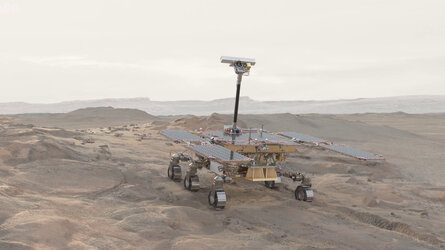Accept all cookies Accept only essential cookies See our Cookie Notice

About ESA
The European Space Agency (ESA) is Europe’s gateway to space. Its mission is to shape the development of Europe’s space capability and ensure that investment in space continues to deliver benefits to the citizens of Europe and the world.
Highlights
ESA - United space in Europe
This is ESA ESA facts Member States & Cooperating States Funding Director General Top management For Member State Delegations European vision European Space Policy ESA & EU Space Councils Responsibility & Sustainability Annual Report Calendar of meetings Corporate newsEstablishments & sites
ESA Headquarters ESA ESTEC ESA ESOC ESA ESRIN ESA EAC ESA ESAC Europe's Spaceport ESA ESEC ESA ECSAT Brussels Office Washington OfficeWorking with ESA
Business with ESA ESA Commercialisation Gateway Law at ESA Careers Cyber resilience at ESA IT at ESA Newsroom Partnerships Merchandising Licence Education Open Space Innovation Platform Integrity and Reporting Administrative Tribunal Health and SafetyMore about ESA
History ESA Historical Archives Exhibitions Publications Art & Culture ESA Merchandise Kids Diversity ESA Brand Centre ESA ChampionsLatest
Space in Member States
Find out more about space activities in our 23 Member States, and understand how ESA works together with their national agencies, institutions and organisations.
Science & Exploration
Exploring our Solar System and unlocking the secrets of the Universe
Go to topicAstronauts
Missions
Juice Euclid Webb Solar Orbiter BepiColombo Gaia ExoMars Cheops Exoplanet missions More missionsActivities
International Space Station Orion service module Gateway Concordia Caves & Pangaea BenefitsLatest
Space Safety
Protecting life and infrastructure on Earth and in orbit
Go to topicAsteroids
Asteroids and Planetary Defence Asteroid danger explained Flyeye telescope: asteroid detection Hera mission: asteroid deflection Near-Earth Object Coordination CentreSpace junk
About space debris Space debris by the numbers Space Environment Report In space refuelling, refurbishing and removingSafety from space
Clean Space ecodesign Zero Debris Technologies Space for Earth Supporting Sustainable DevelopmentLatest
Applications
Using space to benefit citizens and meet future challenges on Earth
Go to topicObserving the Earth
Observing the Earth Future EO Copernicus Meteorology Space for our climate Satellite missionsCommercialisation
ESA Commercialisation Gateway Open Space Innovation Platform Business Incubation ESA Space SolutionsLatest
Enabling & Support
Making space accessible and developing the technologies for the future
Go to topicBuilding missions
Space Engineering and Technology Test centre Laboratories Concurrent Design Facility Preparing for the future Shaping the Future Discovery and Preparation Advanced Concepts TeamSpace transportation
Space Transportation Ariane Vega Space Rider Future space transportation Boost! Europe's Spaceport Launches from Europe's Spaceport from 2012Latest

Eyes on Mars
Thank you for liking
You have already liked this page, you can only like it once!
Humans can only see colours in visible light. Europe’s martian rover has a wider range of vision to search for past and present signs of life on Mars.
The ExoMars Rosalind Franklin rover is equipped with scientific eyes atop its mast, on a panoramic camera suite called PanCam. From its vantage point about two metres above the ground, PanCam cameras come into play to get the big picture with high resolution imaging.
PanCam can ‘see’ in 19 colours, in the visible and near infrared wavelengths. Each of its two wide-angle cameras has a filter wheel with 11 positions to look at the colours of the rocks and the martian sky. Scientists can create 3D pictures and depth maps by overlaying simultaneous snapshots. A high-resolution camera is used to study very fine details in exposed bedrocks, rocks and soils, such as rock texture, laminations and grain size in colour.
In this computer image, Rosalind Franklin approaches a slightly elevated area in Oxia Planum – the landing site for ESA’s Rosalind Franklin rover on Mars. The terrain depicts a few mounds that could be the remains of some wind-eroded vents. Since fluids could have broken through the vents, this represents a very interesting formation to look for biosignatures – the evidence of past or present life.
Enfys, meaning rainbow in Welsh, is the ExoMars' rover infrared spectrometer to study mineral composition. Enfys and PanCam will work in synergy: PanCam is used to obtain colour and visual information of what lies around the rover, while Enfys’ job is to inform scientists of what minerals are present.
All these images of the terrain are essential for scientists on Earth to understand the geological context on Mars. Identifying minerals formed in the presence of water, for example, could guide the rover to the best places for drilling and collecting samples. Rosalind Franklin will be the first rover to drill two metres below the surface, and Enfys and PanCam will let it know where it should go.
Fast forward to the future and watch the first episode of the ExoMars Rosalind Franklin rover mission. The episode starts after a successful descent and landing on the Red Planet in 2030.
-
CREDIT
ESA/Mlabspace -
LICENCE
ESA Standard Licence and Additional permission may be required
(contact spaceinimages@esa.int for further information)

Episode 1 – Scouting the Red Planet

ExoMars PanCam filters

Below the surface - ExoMars Rosalind Franklin mission

PanCam mast fitted to ExoMars rover















 Germany
Germany
 Austria
Austria
 Belgium
Belgium
 Denmark
Denmark
 Spain
Spain
 Estonia
Estonia
 Finland
Finland
 France
France
 Greece
Greece
 Hungary
Hungary
 Ireland
Ireland
 Italy
Italy
 Luxembourg
Luxembourg
 Norway
Norway
 The Netherlands
The Netherlands
 Poland
Poland
 Portugal
Portugal
 Czechia
Czechia
 Romania
Romania
 United Kingdom
United Kingdom
 Slovenia
Slovenia
 Sweden
Sweden
 Switzerland
Switzerland
























